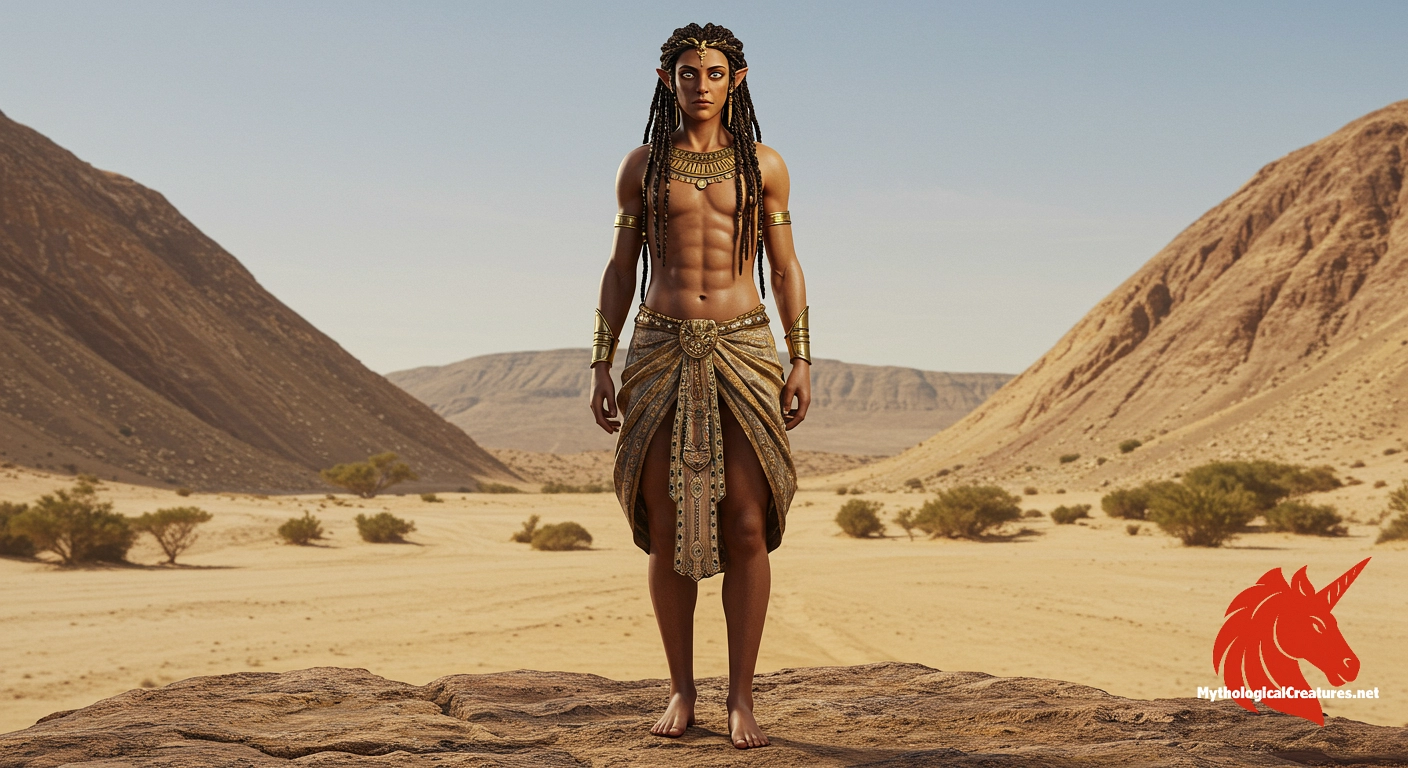Lybie: Lybie is a mother figure in Greek mythology who personifies and rules over the land of Libya.

Lybie
Lybie - Lybie embodies the personification of Libya's land and serves as a symbolic figure representing the country's identity and regal authority in Greek mythology.
Origins & First Encounters
Lybie, also known as Libye, emerges from the ancient Greek mythic tradition as a personification and sovereign embodiment of the land of Libya.
Her origins are intertwined with the divine, as she is celebrated for her union with Poseidon and her role as the mother of Belus.
In early mythological narratives, she is portrayed as the very spirit of Libya, embodying a deep connection between the earth and its people.
Her first attestation can be traced back to classical texts where the boundaries between humans and deities blurred in the retelling of creation myths.
The cultural context of her legend reflects an intimate relationship between the Greeks and the North African landscape, where geography often inspired divine personification.
Beyond her role as a consort and mother, Lybie serves as an allegory for the natural beauty and mystique of a distant, exotic land.
The duality of her character—both nurturing and authoritative—resonates with the ancient belief in the power of nature intertwined with divine lineage.
Her myth not only lays the groundwork for the divine ancestry of subsequent royal lines but also cements her place as an enduring symbol of Libya’s mystique and allure.
Source Texts & Tale Variants
Ancient literary fragments and classical sources provide the earliest glimpses into Lybie’s myth, revealing a figure both enigmatic and profoundly significant.
Her story appears sporadically in works that explore the genealogy of gods and kings, thus underscoring her role in linking the divine with the mortal realm.
Primary sources, though brief, hint at her pivotal relationship with Poseidon and her subsequent role in establishing a mythic lineage through her son, Belus.
Some versions of her narrative extend her maternity to include Lamia, thereby offering varied interpretations across the ancient world.
Different storytellers and local traditions contributed nuances that enriched her myth, each adding layers to her portrayal as both a goddess and a queen.
These story variants reveal that her character was not fixed but evolved as writers sought to explain regional histories and cultural identities.
The scattered mythological references provide a mosaic of interpretations, enabling later scholars to piece together a composite image of her significance.
The fluidity of her portrayal underscores the inherent flexibility in myth-making, where the sacred and the historical merge seamlessly.
Ultimately, the diversity of sources stands as a testament to her widespread influence and the enduring appeal of her legend.
Form & Powers
In artistic depictions and literary accounts, Lybie is often envisioned as an arresting and regal maiden, whose features embody the harsh beauty of the North African landscape.
Her countenance is described as both dignified and serene, reflecting an inner strength and maternal grace that befits her divine status.
Imagery suggests that she wears flowing garments that echo the vibrant, sun-drenched colours of the desert, each fold hinting at the mystery of her origins.
Her hair is frequently depicted as dark and lustrous, cascading in waves that evoke the undulating dunes of Libya.
Many ancient vases and sculptures illustrate her with a subtle halo or diadem, symbolising her status as a queen as well as a divine presence.
The variations in her portrayal range from an almost ethereal appearance to a more robust and heroic representation, which underscores her complex nature.
Details such as her eyes, often likened to the clear blue skies or the midnight desert, have been interpreted as windows into her transcendent power.
Her physical form, while idealised, carries traces of the elemental forces of both the land and the sea, alluding to her connection with Poseidon.
Overall, her iconography skilfully blends regality with the raw and untamed spirit of the Libyan terrain.
Regional Faces
The myth of Lybie adapts significantly across different cultural landscapes, reflecting the diversity of the Mediterranean and North African traditions.
In Greek narratives, she is primarily seen as the personification of Libya, symbolising both the vastness and fertility of the region.
Local traditions in North Africa have recast her as a guardian of the land, imbuing her with attributes that emphasise nature’s dual capacity for abundance and desolation.
In some regional accounts, she is revered not only as a divine matriarch but also as a protector whose legacy influences local rites and customs.
The nuances of her story vary, with certain areas highlighting her role as the mother of both Belus and Lamia, while others focus solely on her symbolic representation of the territory.
These adaptations show a vibrant local engagement with her myth, where oral and artistic traditions have added layers of meaning over time.
The interplay between Greek literary depictions and indigenous interpretations has resulted in a multifaceted character whose identity is both local and universal.
Her narrative, therefore, acts as a cultural bridge, integrating varied perspectives on divinity, nature, and national identity.
Thus, the regional variations not only enrich her myth but also highlight the broader tendency of cultures to intertwine the divine with the geographical.
Cultural Parallels
In the broad spectrum of mythological lore, Lybie stands as a distinctive figure whose role as a land deity finds parallels with other well-known personifications of territory and nature.
Much like Gaia in Greco-Roman mythology, she personifies not just a physical space but the spirit of an entire region.
This comparative analysis reveals similarities with other cultural icons, such as the Mesopotamian goddess of the earth or the Roman deities who embodied specific regions of the empire.
Her characterization as both a sovereign and a nurturing mother resonates with the universal mythic archetype of the earth mother, revered in various ancient traditions.
Although her domain is more narrowly defined, the symbolism underpinning her representation echoes that of other ancient goddesses who bridged the realms of divinity and natural order.
This cross-cultural commonality speaks to the human impulse to personify the land, thereby granting it a face that embodies its intrinsic qualities.
The intermingling of divine ancestry, as seen in her connection with Poseidon, mirrors similar motifs in neighbouring mythologies where gods forge bonds with the very elements they govern.
Such comparisons underscore a timeless narrative thread where myth and geography intertwine to form a collective identity.
Ultimately, Lybie’s legend contributes to a pan-cultural dialogue about the sacredness of the land and the enduring power of myth in shaping regional identities.
Legacy & Modern Evolution
The narrative of Lybie has evolved significantly from its ancient origins, reflecting both historical developments and modern reinterpretations of myth.
In early Greek literature, she was celebrated as the divine personification of Libya, a concept that laid the foundations for later interpretations of national identity and territorial spirit.
Over the centuries, her image has been adapted by a succession of cultures, each adding their own symbolism and artistic flourish to her tale.
The Renaissance, with its renewed interest in classical antiquity, saw Lybie reimagined as a symbol of both natural grandeur and feminine power, inspiring a number of visual and literary works.
Modern artists and writers have further recontextualised her as an emblem of resilience and identity, particularly in discussions surrounding post-colonial narratives in North Africa.
Her evolving legacy illustrates how ancient myths can be revitalised to speak to contemporary issues, bridging the gap between past and present.
Lybie’s story continues to influence academic debates, cultural festivals, and artistic expressions that celebrate the enduring spirit of Libya.
This transformation highlights the dynamic nature of myth, where ancient narratives are continuously reinterpreted in light of new cultural and historical understandings.
Thus, her modern legacy is not confined to the annals of the past but remains a vibrant part of the cultural dialogue in the present.
Interesting Fact
Lybie uniquely merges the roles of a divine mother and a personified nation, embodying both the maternal lineage of myth and the sovereign identity of a land.
Quick Creature Info
Origin:
Features:
Our Mythic Legendary Rating:

Also Sometimes Known As:
Habitat:
Supernatural Powers:
Physical Attributes:
Behavior:
Lore:
Related Creatures, Tales or Lore
- EEuropa
- AAsia
- BBritannia
References
Discover Another Mythical Legend You May Not Have Heard Of?
Uncover the mysteries of ancient folklore and expand your knowledge of legendary beings from cultures around the world.
Dare to Meet the Hrymr....
Mythical Disclaimer: The images and data on this site are derived from various historical and literary sources, but we have found that many myths often have multiple versions and interpretations across references, sometimes contradictory. As a result, these creature depictions are artistic interpretations—imaginative blends of folklore, legend, and a dash of AI guesswork. Because creature descriptions vary widely, our illustrations and accompanying information represent our best effort to honor mythology while bridging creative gaps. Enjoy these interpretations—just remember, we've done our best to respect the stories and validate available data, but in the realm of mythology, details often shift, imagination leads the way, and nothing is ever set in stone!
Curated by the Mythological Creatures Team (rev. May 2025)
